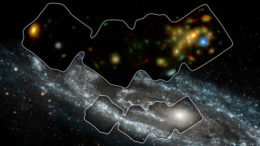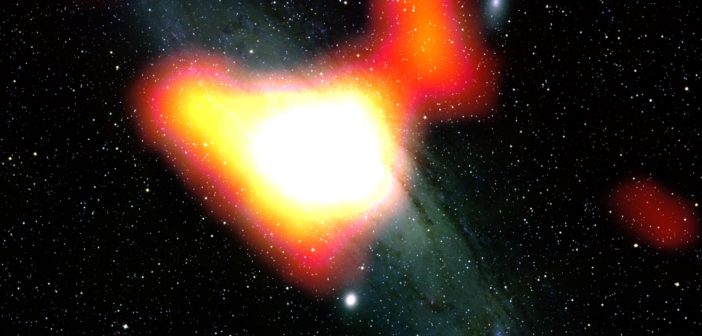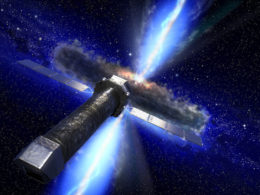Editor’s note: This week we’re in Sun Valley, Idaho at the 16th meeting of the AAS High Energy Astrophysics Division (HEAD). Follow along to catch some of the latest news from the field of high energy astro!
Session: AGN 1
Ehud Bahar (Technion) opened the meeting’s first session on active galactic nuclei (AGN) by discussing eclipses of a different kind than the one we observed on Monday. Light from AGN is often obstructed on its path to us by warm, outflowing, intervening material that absorbs some of the AGN’s light. Bahar explained the difference between what he termed “absorbers” and “obscurers”: absorbers are slow and steady outflows from the AGN that change very little over long timescales. These provide us with the opportunity to probe their detailed physics. Obscurers, on the other hand, are fast-moving and transient outflows, briefly causing dramatic drops in the X-ray flux of the AGN.

Artist’s impression of the tidal disruption event ASASSN-14li, in which a supermassive black hole destroyed a star, launching outflows. [NASA GSFC]
Andrew Fabian (University of Cambridge) wrapped up the session by providing an overview of what we know about AGN coronae — the incredibly luminous, compact regions that lie directly above the accretion disks of supermassive black holes. Coronae are the source of the majority of the hard X-ray emission from AGN, and we have used observations of this emission to constrain the size of AGN coronae to a mere 10 gravitational radii. We’ve learned that coronae are extremely hot, at 30–300 keV, and are highly magnetized and dynamic, likely containing outflowing plasma.
Session: The Very High Energy Universe as Viewed with VERITAS and HAWC
The session on very high energy observations opened with a talk by Brenda Dingus (LANL). Dingus introduced us to the High Altitude Water Cherenkov (HAWC) gamma-ray observatory, a new observatory located in Mexico that maps the northern sky in high-energy gamma rays. HAWC has a wide field of view, observing roughly 2/3 of the sky each day with long integration times. This means that the observatory is sensitive to the highest energy gamma rays. HAWC has recently released its very first catalog, 2HWC, and this is only the beginning — there is much more science expected from this observatory in the future!The Very Energetic Radiation Imaging Telescope Array System (VERITAS) is another high-energy observatory, located in southern Arizona; Philip Kaaret (University of Iowa) provided us with an overview of this set of telescopes. VERITAS has a narrower field of view than HAWC, but its sensitivity and angular resolution are higher, allowing it to probe sources at a deeper level. It’s therefore often used for follow-up observations of known targets.
So what sources are high-energy observatories like VERITAS and HAWC observing? They hunt for photons from astrophysical sources like supernova remnants, pulsar wind nebulae, active galactic nuclei, gamma-ray bursts, and dark matter annihilation. Oleg Kargaltsev (George Washington University), Sara Buson (NASA GSFC), and Matthew Baring (Rice University) each explained some of the insights we’ve obtained about these objects from observatories like HAWC, VERITAS, Fermi, and MAGIC in conjunction with observatories exploring other wavelengths.
Mid-Career Prize Talk: X-ray Winds from Black Holes
Tuesday afternoon kicked off with the HEAD Mid-Career Prize Talk, given this year by Jon Miller (University of Michigan). Miller spoke in further depth about a topic introduced earlier in the day: winds emitted from black hole disks. He argued that these winds are worth studying because they provide information about how mass is accreted onto black holes, and therefore how the black holes grow and their spins evolve.
The dense and ionized winds from black-hole disks can potentially carry away more mass than is accreted — and this appears to hold true across the mass scale, from X-ray binaries containing stellar-mass black holes to Seyfert galaxies containing supermassive black holes. Miller discussed the different mechanisms that may launch these winds, and how observations indicate that magnetic driving is important, although other forces may also be at work.
Miller argued that many tests of disk physics are now within reach of data and simulations, such as measurements of disk magnetic fields. He also showed how extreme settings such as tidal disruption events can provide a unique and interesting regime in which to explore disks and winds, as the mass accretion rate in these events changes drastically on observable timescales.As a final point, Miller discussed how our understanding of black hole disk winds will change with upcoming observatories. Missions like Xarm, ARCUS, ATHENA, Lynx, etc. will be transformative; ATHENA, for instance, will be able to produce observations outstripping the sensitivity and resolution of any observations obtained so far with current instrumentation, in “less than the time it took you to have lunch today,” Miller explained.
Session: ISM & Galaxies
Xian Hou (Yunnan Observatories) opened the session on the interstellar medium (ISM) and galaxies by discussing our view of M31 (the Andromeda galaxy) with the Fermi Large Area Telescope. M31 is the only other large spiral local galaxy — and it’s nearby, providing an excellent opportunity for resolved analysis of high-energy emission from a large, star-forming, spiral galaxy similar to the Milky Way. The >1 GeV emission tracked by Fermi LAT was found to be concentrated only in the inner region of the galaxy; it is not correlated with interstellar gas or star-formation sites. What could be this emission’s source, then? Hou suggests that possibilities include a population of millisecond pulsars in the galactic center, or annihilation/decay of dark matter.

NuSTAR observations of M31. The bright blue point in the inset is the intermediate-mass pulsar candidate. [NASA/JPL-Caltech]
The work done by Francesca Fornasini (Harvard-Smithsonian CfA) and collaborators explores how low-luminosity AGN activity and star formation in its host galaxy are connected. Is there a correlation between these two types of activity? If there’s a positive correlation, we can infer that AGN feedback suppresses star formation; if there is a negative correlation, both types of activity may be fueled by a common mechanism. On the other hand, there may be no correlation at all! Because AGN are variable, and because the relation between AGN activity and star formation rate can vary with other host galaxy properties like stellar mass and redshift, we need a very large sample that covers the whole phase space to test for correlation. Fornasini and collaborators achieve this by building X-ray stacks from data from 123,000 galaxies in the Chandra COSMOS Legacy Survey. Their work is still underway, but thus far it has revealed no correlation between the black-hole accretion rate and the star formation rate of the host galaxies.




2 Comments
Pingback: 2017 HEAD: Day 2 – MeasurementDataBases for Industry & Science
Pingback: AAS HEAD Day 2